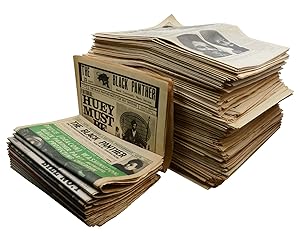black panther party emory douglas (1 Ergebnisse)
Produktart
- Alle Produktarten
- Bücher (1)
- Magazine & Zeitschriften
- Comics
- Noten
- Kunst, Grafik & Poster
- Fotografien
- Karten
-
Manuskripte &
Papierantiquitäten
Zustand
- Alle
- Neu
- Antiquarisch/Gebraucht
Einband
- alle Einbände
- Hardcover
- Softcover
Weitere Eigenschaften
- Erstausgabe
- Signiert
- Schutzumschlag
- Angebotsfoto
Land des Verkäufers
Verkäuferbewertung
-
The Black Panther: Black Community News Service (Collection of 233 issues, 1967-1980)
Verlag: The Black Panther Party, Oakland & San Francisco, 1980
Anbieter: Burnside Rare Books, ABAA, Portland, OR, USA
Erstausgabe
First edition. An extensive collection of 236 numbers in 233 issues (Volume 2, Numbers 15-17 are printed in a single volume and Volume 6, Numbers 13 and 14 are as well). Intermittent run spanning from the first volume to the final volume (the 20th). Newspaper changed title to The Black Panther Intercommunal News Service on March 13, 1971.Contents: Volume 1, Number 6; Vol. 2, Nos. 1-3, 5-7, (15-17), 18, 19, 21; Vol. 3, Nos. 1, 3, 6, 7, 9-12, 16, 17, 19-21, 26, 27, 29, 29 [sic], 31; Vol. 4, Nos. 3, 3 [sic], 4, 7, 8, 8 [sic], 9, 12-15, 17, 18, 18 [but 19], 20, 21, 22, 22 [sic], 27, 28, 28 [sic], 29; Vol. 5, Nos. 4, 12, 13, 15-18, 20-25, 27, 30; Vol. 6, Nos. 1-6, 10, 11, (13-14), 16, 18, 21, 23-30; Vol. 7, Nos. 1, 3, 8, 19-27, 29, 30; Vol. 8, Nos. 1-25, 28-30; Vol. 9, Nos. 1, 3-8, 10, 12-15; Vol.10, Nos. 15, 18, 23, 25, 27, 28, 30; Vol. 11, Nos. 12, 14, 15, 21, 23, 26, 29; Vol. 12, Nos. 1, 7, 12, 15, 16, 30; Vol. 13, Nos. 2, 7, 11, 12, 19, 20, 21, 29, 30; Vol. 14, Nos. 4, 8, 11-13, 15, 17, 18, 28; Vol. 15, Nos. 3, 10-15, 26-30, 30 [sic]; Vol.16, Nos. 4, 5, 8-11, 13, 18, 27-30; Vol. 17, No. 29; Vol. 18, Nos. 1, 3-9, 11, 16-19, 22-26, 28, 29, 29 [sic]; Vols. 19, Nos. 3, 5-7, 7 [sic], 8, 9; Vol. 20, Nos. 1, 3; Extra, Saturday, October 5th, 1968 [Unnumbered]. A well-preserved and very substantial run of the Black Panther Party's official newspaper, with the issues representing a large swath of the paper's content, circulation, and overall aesthetic. In terms of content, Huey Newton was acknowledged as the chief theoretician of the Party and its newspaper, though in terms of generating mass-appeal, much of the credit goes to Emory Douglas: "Douglas's work on the Black Panther newspaper and for the party was fearless in content and style. He was the party's Revolutionary Artist, graphic designer, illustrator, political cartoonist, and the master craftsman of its visual identity. His distinctive illustrations styles, cartooning skills, and resourceful collage and image recycling made the paper as explosive visually as it was verbally.Part of Douglas's genius was that he used the visually seductive methods of advertising and subverted them into weapons of the revolution. His images served two purposes: to illustrate conditions that made revolution a reasonable response and to construct a visual mythology of power for people who felt powerless and victimized" (Durant, Sam (ed). Black Panther: The Revolutionary Art of Emory Douglas, pp.95-96).Contains an over-arching glimpse of the art, layout, production and content of the newspaper as well as the rise and fall of the Black Panther Party, with issues ranging from the earliest days through 1980. Visually stunning and innovative in its design and layout, they tell the story of the Black Panthers' struggle fighting racism and institutional violence and oppression. A key publication responsible for shaping African American revolutionary thought in the twentieth century; runs this extensive are very uncommon in commerce.


